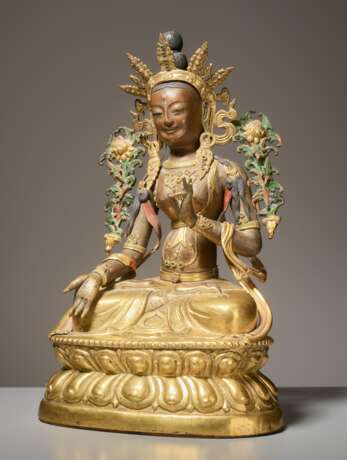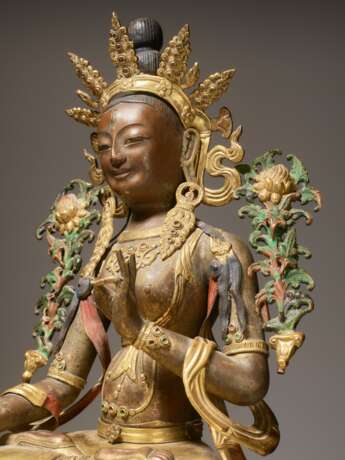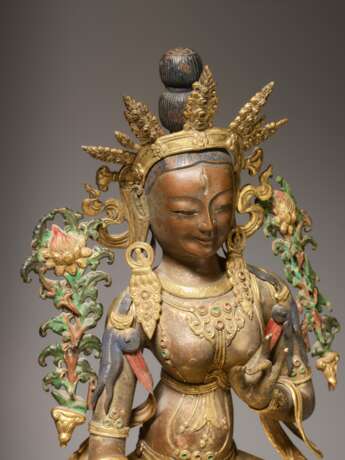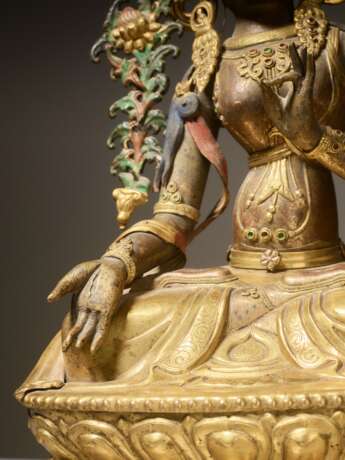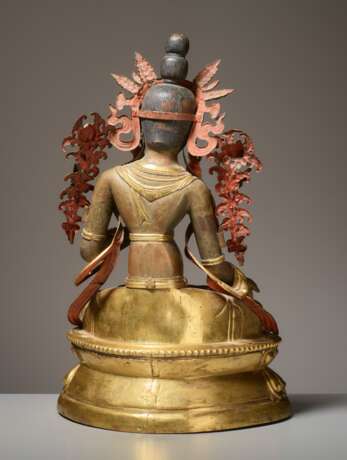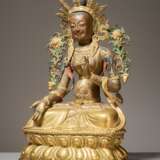ID 907
Lot 37 | GROSSE VERGOLDETE KUPFER-REPOUSSÉ FIGUR DER WEISSEN TARA
Estimate value
€ 10 000
Kupfer, Bronze und Repoussé, teilweise Feuervergoldet
Nepal
ca. 17. bis 18. Jahrhundert
HÖHE 39,5 CM
Sitatara, die Weiße Tara, ein Bodhisattva des Mitleids (auch als “Retterin” interpretiert), sitzt in vollkommen geschlossenem Padmasana (Lotussitz) auf einem wirkungsvoll prangendem Lotusthron. Eine Hand hält sie im Gestus der Wunscherfüllung Varadamudra, die erhobene sollte den Stengel der Lotusblume halten (verloren) und bildet mit den hörnerartig hochgestellten Fingern die Dämonenabwehr Karanamudra. Die Gesichtszüge sind besonders fein und sinnlich gebildet, das Feminin-Sinnliche ist ebenso besonders in den vollen Brüsten und der engen Taille hervorgehoben. Detailliert genau ausgeführter vielfältiger Schmuck am Körper, an den Ohren und in der fünfzackigen Krone. Das markanteste Merkmal dieser Form der Sitatara ist ihre Siebenäugigkeit, außer den natürlichen weitere auf Handflächen, Fußsohlen und Stirn. Mit diesen wird ihre überragende Weisheit und Weitsichtigkeit apostrophiert. Seitlich der Schultern die Lotusblüten, lange Haarzöpfe und auf dem Kopf ein hoher Chignon. Diese Tara ist zusammengesetzt aus repoussierten und gegossenen Teilen, wie dies für diese Technik üblich war. Kopf, Oberkörper, Arme und Hände sind teilweise repoussiert, teilweise gegossen und nicht vergoldet, Zierbänder und Schmuck ausgenommen. Lotussitz und Lotusthron, Schalgirlanden, Lotusblüten, Krone und der Chignon sind dagegen getriebene Arbeit. Der Sockel ist unterseits mit Holz verschlossen, insgesamt jedoch außerordentlich gute Erhaltenheit, schöne Vergoldung und Kaltbemalung. Die Krone und die seitlich angebrachten Lotusblüten sind abnehmbar.
Expertise: Wolfmar Zacken
Aus einer litauischen Privatsammlung
| Address of auction |
Galerie Zacke Mariahilferstrasse 112 1070 Wien Austria | ||||||||||||||
|---|---|---|---|---|---|---|---|---|---|---|---|---|---|---|---|
| Preview |
| ||||||||||||||
| Phone | +00 4315-320 452 | ||||||||||||||
| Fax | +43-1-5320452-20 | ||||||||||||||
| Buyer Premium | 27.000 | ||||||||||||||
| Conditions of purchase | Conditions of purchase | ||||||||||||||
| Business hours | Business hours
|
